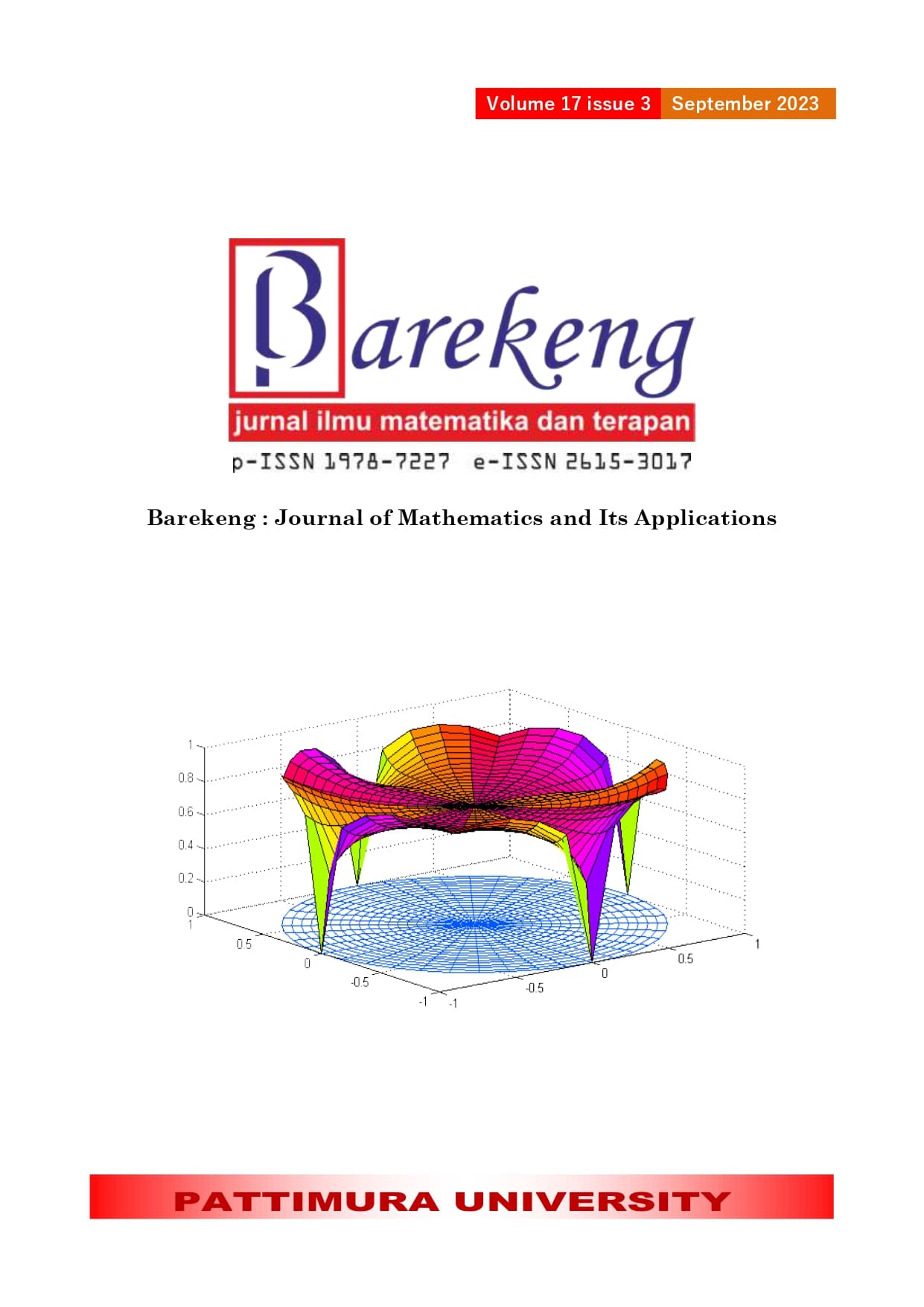TUBERCULOSIS CASE MODEL USING GCV AND UBR KNOT SELECTION METHODS IN TRUNCATED SPLINE NONPARAMETRIC REGRESSION
Abstract
The nonparametric regression approach is used when the shape of the regression curve is not known. The advantage of nonparametric regression is that it has a high degree of flexibility. The truncated spline is a method in the nonparametric regression approach, which can overcome changing data patterns at certain sub-intervals with the help of knot points. The purpose of this research is to obtain the best truncated spline nonparametric regression model estimates based on the GCV and UBR knot point selection methodsThe data used in this study came from the publications of the Indonesian Ministry of Health and BPS Indonesia. The response variable used is the percentage of successful treatment of tuberculosis patients in Indonesia with predictor variables namely the percentage of people who smoke over the age of 15 years, the percentage of households that have access to proper sanitation, the percentage of poor people, the percentage of food processing establishments that meet the standard requirements , national health insurance membership coverage and percentage of accredited hospitals. The results showed that the best model came from the GCV method using three knots. This model produces an MSE value of 3.65 with value of 97.04. The value indicates that the predictor variable used in this study affects the response variable by 97.04% while the other 2.96% is influenced by other variables that are not included in this study.
Downloads
References
S. Sifriyani, S. H. Kartiko, and G. Gunadi, “Development of Nonparametric Geographically Weighted Regression Using Truncated Spline Approach,” Songklanakarin J. Sci. Technol., vol. 40, no. 2, 2018.
S. Sifriyani, H. Ilmi, and Z. Mar’ah, “Application of Nonparametric Geographically Weighted Spline Regression Model for Spatial Mapping of Open Unemployment Rate in Kalimantan Application of Nonparametric Geographically Weighted Spline Regression Model for Spatial Mapping of Open Unemployment,” J. Phys. Conf. Ser., vol. 2123, no. 1, p. 012038, 2021.
F. R. Sihotang, S. Sifriyani, and S. Prangga, “Aplikasi Regresi Nonparametrik Spline Birespon Pada Data Kualitas Air Di Das Mahakam,” Media Bina Ilm., vol. 16, no. 3, pp. 6515–6526, 2021.
S. Sifriyani, I. N. Budiantara, S. H. Kartiko, and G. Gunadi, “A New Method of Hypothesis Test for Truncated Spline Nonparametric Regression Influenced by Spatial Heterogeneity and Application, Abstract and Applied Analysis,” vol. 2018.
A. B. Padatuan, S. Sifriyani, and S. Prangga, “Bayi Di Kalimantan Dengan Regresi Nonparametrik Spline Birespon,” BAREKENG J. Ilmu Mat. dan Terap., vol. 15, no. 2, pp. 283–296, 2021.
S. Sifriyani, “Simultaneous Hypothesis Testing of Multivariable Nonparametric Spline Regression in the GWR Model,” Int. J. Stat. Probab., vol. 8, no. 4, pp. 32–46, 2019.
T. Purnaraga and S. Prangga, “Regresi Nonparamaetrik Spline Pada Data Laju Pertumbuhan Ekonomi Di Kalimantan,” BAREKENG J. Ilmu Mat. dan Terap., vol. 14, no. 3, pp. 343–356, 2020.
R. N. Zarkasi, S. Sifriyani, and S. Prangga, “Identifikasi Faktor-Faktor Yang Mempengaruhi Menggunakan Regresi Panel,” BAREKENG J. Ilmu Mat. dan Terap., vol. 15, no. 2, pp. 277–282, 2021.
E. M. Purbasari, T. W. Utami, and M. Al Haris, “Perbandingan Pemilihan Titik Knot Optimal Menggunakan Metode Unbiased Risk (UBR) Dan Generalized Cross Validation (GCV) Dalam Regresi Nonparametrik Spline (Studi Kasus: Jumlah Kematian Bayi di Provinsi Jawa Tengah 2017),” 2019.
W. Nurmalisa and I. M. Nur, “Pemodelan Regresi Nonparametrik Spline dengan Pemilihan Titik Knot Optimal Menggunakan Metode Unbiased Risk dan Generalized Cross Validation pada Kasus Indeks Pembangunan Manusia di Jawa Tengah,” Pros. Semin. Nasioanl Mhs. Unimus, vol. 2, pp. 344–355, 2019.
Kementerian Kesehatan Republik Indonesia, Profil Kesehatan Indonesia 2020, no. 1. Jakarta, 2021.
M. H. Pratama, Sifriyani, and D. A. Nohe, “Regresi Nonparametrik Multivariabel dengan Pendekatan Spline Truncated Pada Kasus Tuberculosis,” vol. 22, no. 1, pp. 87–93, 2022.
N. Evitasari, S. S. Handajani, and H. Pratiwi, “Pemodelan Faktor-Faktor Yang Memengaruhi Kesembuhan Tuberkulosis Di Provinsi Jawa Timur Dengan Regresi Nonparametrik Spline Truncated,” Semin. Nas. Pendidik. Mat., vol. 3, no. 1, pp. 107–118, 2020.
H. Yozza and A. Afrimayani, “Konstruksi Model Hubungan Dua Variabel Dengan Analisis Regresi Spline,” Sainstek J. Sains dan Teknol., vol. 11, no. 1, p. 16, 2019.
E. K. Litawati and I. N. Budiantara, “Pendekatan Regresi Nonparametrik Spline Untuk Pemodelan Laju Pertumbuhan Ekonomi ( LPE ) di Jawa Timur,” J. Sains Dan Seni POMITS, vol. 2, no. 2, pp. 2337–3520, 2013.
M. D. Pasarella, S. Sifriyani, and F. D. T. Amijaya, “Nonparametric Regression Model Estimation With The Fourier Series The Fourier Series Approach And Its Application To The Accumulative Covid-19 Data In Indonesia,” BAREKENG J. Ilmu Mat. dan Terap., vol. 16, no. 4, pp. 1167–1174, 2022.
S. Sifriyani, M. Rasjid, D. Rosadi, S. Anwar, R. D. Wahyuni, and S. Jalaluddin, “Spatial-Temporal Epidemiology of COVID-19 Using a Geographically and Temporally Weighted Regression Model,” Symmetry (Basel), vol. 14, no. 4,2022.
Z. Tupti, N. I. Purnama, and D. Novita, “Analisis Faktor Determinasi Kinerja Karyawan,” Proceding Semin. Nas. Kewirausahaan, vol. 2, no. 1, pp. 512–524, 2021.
M. Sriningsih, D. Hatidja, and J. D. Prang, “Penanganan Multikolinearitas Dengan Menggunakan Analisis Regresi Komponen Utama Pada Kasus Impor Beras Di Provinsi Sulut,” J. Ilm. Sains, vol. 18, no. 1, 2018.
Copyright (c) 2023 Sitti Anggraeni, Sifriyani Sifriyani, Qonita Qurrota A'yun

This work is licensed under a Creative Commons Attribution-ShareAlike 4.0 International License.
Authors who publish with this Journal agree to the following terms:
- Author retain copyright and grant the journal right of first publication with the work simultaneously licensed under a creative commons attribution license that allow others to share the work within an acknowledgement of the work’s authorship and initial publication of this journal.
- Authors are able to enter into separate, additional contractual arrangement for the non-exclusive distribution of the journal’s published version of the work (e.g. acknowledgement of its initial publication in this journal).
- Authors are permitted and encouraged to post their work online (e.g. in institutional repositories or on their websites) prior to and during the submission process, as it can lead to productive exchanges, as well as earlier and greater citation of published works.






1.gif)



